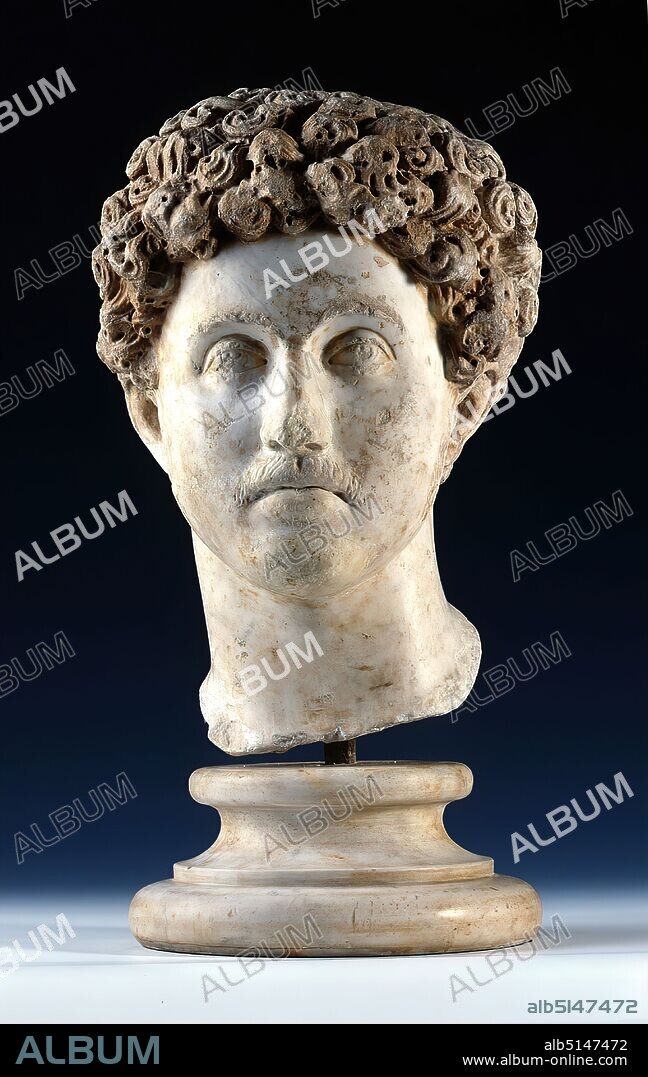alb5147472
Portrait of Emperor Marcus Aurelius, marble, chiseled, drilled, beaten, marble, Total: Height: 43 cm (without base); Width: 31 cm; Depth: 31,5, Sculptures, Portrait, Emperor, Ruler's Portrait, State Portrait, Historical Person, Hairstyle Fashion, Hair Fashion, Roman Empire, Emperor Marcus Aurelius, Middle Imperial Period, The larger-than-life portrait shows a young man whose facial features are calm and unemotional The main hair is curled profusely and is a clear contrast to the beginning beard growth that can be seen on the upper lip and cheeks. Comparison with other surviving portraits - including those on coins that can be dated well - allows the sitter to be identified as the youthful Marcus Aurelius. This is the so-called 2nd type of portrait, which shows the young prince. The larger-than-life-size portrait was an insert head that once belonged to a statue about 3 m high, which is lost today. Marcus Aurelius Antoninus - so his full name - was born in Rome in 121 A.D. into an old noble family. In 138 A.D. the later emperor Antoninus Pius adopted him as heir to the throne. In 161 A.D. Marcus Aurelius finally took over the government together with his adopted brother Lucius Verus, which he held until his death in 180 A.D. The 2nd type of portrait probably appeared in 144 A.D. and was widely spread until his accession to the throne in 161 A.D. For the representation as emperor a new portrait type with likewise luxuriant hair, but now with full beard, was chosen. Statues with portrait heads conveyed the presence of the emperor and his family in public or private places such as theaters, spas, forums or residential buildings. Through combinations with different statue bodies - e.g. as a commander, priest, athlete or hero - they could embody virtues that were attributed to the ruler, such as military strength and power (lat. virtus) or loyalty to the gods (lat. pietas). The reign of Marcus Aurelius was marked by several wars against peoples on the edges of the empire,.

|
Añadir a otro lightbox |
|
Añadir a otro lightbox |



¿Ya tienes cuenta? Iniciar sesión
¿No tienes cuenta? Regístrate
Compra esta imagen.
Selecciona el uso:

Descripción:
Ver traducción automática
Portrait of Emperor Marcus Aurelius, marble, chiseled, drilled, beaten, marble, Total: Height: 43 cm (without base); Width: 31 cm; Depth: 31,5, Sculptures, Portrait, Emperor, Ruler's Portrait, State Portrait, Historical Person, Hairstyle Fashion, Hair Fashion, Roman Empire, Emperor Marcus Aurelius, Middle Imperial Period, The larger-than-life portrait shows a young man whose facial features are calm and unemotional The main hair is curled profusely and is a clear contrast to the beginning beard growth that can be seen on the upper lip and cheeks. Comparison with other surviving portraits - including those on coins that can be dated well - allows the sitter to be identified as the youthful Marcus Aurelius. This is the so-called 2nd type of portrait, which shows the young prince. The larger-than-life-size portrait was an insert head that once belonged to a statue about 3 m high, which is lost today. Marcus Aurelius Antoninus - so his full name - was born in Rome in 121 A.D. into an old noble family. In 138 A.D. the later emperor Antoninus Pius adopted him as heir to the throne. In 161 A.D. Marcus Aurelius finally took over the government together with his adopted brother Lucius Verus, which he held until his death in 180 A.D. The 2nd type of portrait probably appeared in 144 A.D. and was widely spread until his accession to the throne in 161 A.D. For the representation as emperor a new portrait type with likewise luxuriant hair, but now with full beard, was chosen. Statues with portrait heads conveyed the presence of the emperor and his family in public or private places such as theaters, spas, forums or residential buildings. Through combinations with different statue bodies - e.g. as a commander, priest, athlete or hero - they could embody virtues that were attributed to the ruler, such as military strength and power (lat. virtus) or loyalty to the gods (lat. pietas). The reign of Marcus Aurelius was marked by several wars against peoples on the edges of the empire,
Crédito:
Album / quintlox
Autorizaciones:
Modelo: No - Propiedad: No
¿Preguntas relacionadas con los derechos?
¿Preguntas relacionadas con los derechos?
Tamaño imagen:
2732 x 4320 px | 33.8 MB
Tamaño impresión:
23.1 x 36.6 cm | 9.1 x 14.4 in (300 dpi)
Palabras clave:
APEGO • APOYO • ATLETA • ATLETAS • ATRIBUIDO • ATTRIBUTED • BARBA LARGA • BASE • CALMA • CINCELADO • COMANDANTE • COMUNIDAD • CONSERVA • CONSIDERA • CURA • DEFUNCION • DEPORTISTA • DERECHO • DIOSES • EJEMPLO • EMPERADOR MARCO AURELIO • EMPERADOR • ENSEÑÓ • EPOCA HELENISTICA • ESCRITURA GRIEGA • ESCULPIDA • ESCULTURA • ESFUERZO • ESTATUA • ESTATUAS • ÉXITO • FAMILIA • FAMILIAR • FAMILIAS • FAMILY • FIDELIDAD • FILOSOFIA • FILOSOFO • FOROS • GOBERNANTE • GRECIA CLASICA • GREEK • GRIEGA • GRIEGAS • GRIEGO • GRIEGOS • HELENICO • HELENISTICO • HEREDERO • HEROE • HOMBRE • IDENTIFICADOS • IMPERIO ROMANO • IMPERIO • INMUEBLES RESIDENCIALES • KAISER • LEALTAD • MARBLE • MARCO AURELIO • MARCO AURELIO, EMPERADOR • MARCOMANOS • MARCUS AURELIUS ANTONINUS • MARCUS AURELIUS • MARMOL • MUERTE • NACIDO • NAZCA • PEINADO • PERFORADOS • PIETAS • PODER • PORTRAIT • PRESENCE • PRESENCIA • PRINCIPE JOVEN • PROFUNDIDAD • PUBLICO • PUEBLOS • REINO • REPRESENTACION • RETRATO DE HOMBRE • RETRATO • ROMA IMPERIAL • ROMA • SACERDOTE • SACERDOTES • STATUE • TEATROS • TRONO • VIDA
 Pinterest
Pinterest Twitter
Twitter Facebook
Facebook Copiar enlace
Copiar enlace Email
Email
